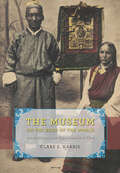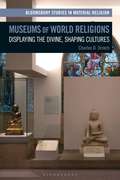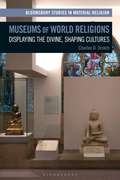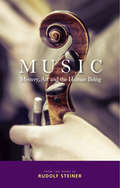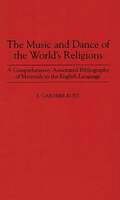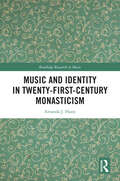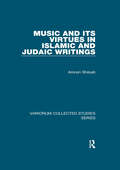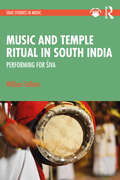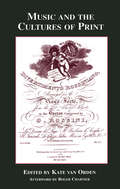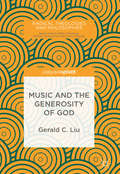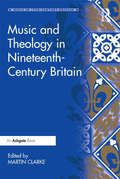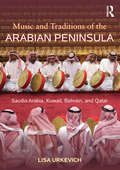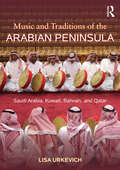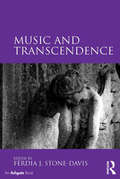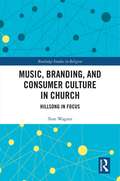- Table View
- List View
The Museum on the Roof of the World: Art, Politics, and the Representation of Tibet (Buddhism and Modernity)
by Clare E. HarrisFor millions of people around the world, Tibet is a domain of undisturbed tradition, the Dalai Lama a spiritual guide. By contrast, the Tibet Museum opened in Lhasa by the Chinese in 1999 was designed to reclassify Tibetan objects as cultural relics and the Dalai Lama as obsolete. Suggesting that both these views are suspect, Clare E. Harris argues in The Museum on the Roof of the World that for the past one hundred and fifty years, British and Chinese collectors and curators have tried to convert Tibet itself into a museum, an image some Tibetans have begun to contest. This book is a powerful account of the museums created by, for, or on behalf of Tibetans and the nationalist agendas that have played out in them. Harris begins with the British public’s first encounter with Tibetan culture in 1854. She then examines the role of imperial collectors and photographers in representations of the region and visits competing museums of Tibet in India and Lhasa. Drawing on fieldwork in Tibetan communities, she also documents the activities of contemporary Tibetan artists as they try to displace the utopian visions of their country prevalent in the West, as well as the negative assessments of their heritage common in China. Illustrated with many previously unpublished images, this book addresses the pressing question of who has the right to represent Tibet in museums and beyond.
The Museum on the Roof of the World: Art, Politics, and the Representation of Tibet (Buddhism and Modernity)
by Clare E. HarrisFor millions of people around the world, Tibet is a domain of undisturbed tradition, the Dalai Lama a spiritual guide. By contrast, the Tibet Museum opened in Lhasa by the Chinese in 1999 was designed to reclassify Tibetan objects as cultural relics and the Dalai Lama as obsolete. Suggesting that both these views are suspect, Clare E. Harris argues in The Museum on the Roof of the World that for the past one hundred and fifty years, British and Chinese collectors and curators have tried to convert Tibet itself into a museum, an image some Tibetans have begun to contest. This book is a powerful account of the museums created by, for, or on behalf of Tibetans and the nationalist agendas that have played out in them. Harris begins with the British public’s first encounter with Tibetan culture in 1854. She then examines the role of imperial collectors and photographers in representations of the region and visits competing museums of Tibet in India and Lhasa. Drawing on fieldwork in Tibetan communities, she also documents the activities of contemporary Tibetan artists as they try to displace the utopian visions of their country prevalent in the West, as well as the negative assessments of their heritage common in China. Illustrated with many previously unpublished images, this book addresses the pressing question of who has the right to represent Tibet in museums and beyond.
The Museum on the Roof of the World: Art, Politics, and the Representation of Tibet (Buddhism and Modernity)
by Clare E. HarrisFor millions of people around the world, Tibet is a domain of undisturbed tradition, the Dalai Lama a spiritual guide. By contrast, the Tibet Museum opened in Lhasa by the Chinese in 1999 was designed to reclassify Tibetan objects as cultural relics and the Dalai Lama as obsolete. Suggesting that both these views are suspect, Clare E. Harris argues in The Museum on the Roof of the World that for the past one hundred and fifty years, British and Chinese collectors and curators have tried to convert Tibet itself into a museum, an image some Tibetans have begun to contest. This book is a powerful account of the museums created by, for, or on behalf of Tibetans and the nationalist agendas that have played out in them. Harris begins with the British public’s first encounter with Tibetan culture in 1854. She then examines the role of imperial collectors and photographers in representations of the region and visits competing museums of Tibet in India and Lhasa. Drawing on fieldwork in Tibetan communities, she also documents the activities of contemporary Tibetan artists as they try to displace the utopian visions of their country prevalent in the West, as well as the negative assessments of their heritage common in China. Illustrated with many previously unpublished images, this book addresses the pressing question of who has the right to represent Tibet in museums and beyond.
The Museum on the Roof of the World: Art, Politics, and the Representation of Tibet (Buddhism and Modernity)
by Clare E. HarrisFor millions of people around the world, Tibet is a domain of undisturbed tradition, the Dalai Lama a spiritual guide. By contrast, the Tibet Museum opened in Lhasa by the Chinese in 1999 was designed to reclassify Tibetan objects as cultural relics and the Dalai Lama as obsolete. Suggesting that both these views are suspect, Clare E. Harris argues in The Museum on the Roof of the World that for the past one hundred and fifty years, British and Chinese collectors and curators have tried to convert Tibet itself into a museum, an image some Tibetans have begun to contest. This book is a powerful account of the museums created by, for, or on behalf of Tibetans and the nationalist agendas that have played out in them. Harris begins with the British public’s first encounter with Tibetan culture in 1854. She then examines the role of imperial collectors and photographers in representations of the region and visits competing museums of Tibet in India and Lhasa. Drawing on fieldwork in Tibetan communities, she also documents the activities of contemporary Tibetan artists as they try to displace the utopian visions of their country prevalent in the West, as well as the negative assessments of their heritage common in China. Illustrated with many previously unpublished images, this book addresses the pressing question of who has the right to represent Tibet in museums and beyond.
Museums of World Religions: Displaying the Divine, Shaping Cultures (Bloomsbury Studies in Material Religion)
by Charles OrzechCritically examining the notion of 'world religions', Charles D. Orzech compares five purpose-built museums of world religions and their online extensions. Inspired by the 19th and 20th century discipline of comparative religion, these museums seek to promote religious tolerance by representing religious diversity and by arguing for underlying kinship among religions. From locations in Europe (Marburg, Glasgow and St Petersburg), to North America (Quebec) to Asia (Taipei), each museum advances a particular cultural history. This book shows how the curation of the objects they contain shapes public perceptions of religion, giving material form to the discourses about religion and world religions.Raising important questions about religion and secularity, museum displays and religious piety, Museums of World Religions questions the ideology that informs these museums. Building on recent anthropological work on the agency of religious objects, the author critiques these museums and suggests new approaches to displaying the matter of religion.
Museums of World Religions: Displaying the Divine, Shaping Cultures (Bloomsbury Studies in Material Religion)
by Charles OrzechCritically examining the notion of 'world religions', Charles D. Orzech compares five purpose-built museums of world religions and their online extensions. Inspired by the 19th and 20th century discipline of comparative religion, these museums seek to promote religious tolerance by representing religious diversity and by arguing for underlying kinship among religions. From locations in Europe (Marburg, Glasgow and St Petersburg), to North America (Quebec) to Asia (Taipei), each museum advances a particular cultural history. This book shows how the curation of the objects they contain shapes public perceptions of religion, giving material form to the discourses about religion and world religions.Raising important questions about religion and secularity, museum displays and religious piety, Museums of World Religions questions the ideology that informs these museums. Building on recent anthropological work on the agency of religious objects, the author critiques these museums and suggests new approaches to displaying the matter of religion.
Music: Mystery, Art and the Human Being
by Rudolf Steiner'Our neurosensory system is inwardly configured music, and we experience music as an artistic quality to the degree that a piece of music is in tune with the mystery of our own musical structure.' - Rudolf SteinerWhat is music? Rudolf Steiner regards the essence of music as something spiritual, inaudible to the senses. The world of tones, borne on the vibrations of air, is not the essential element. 'The true nature of music, the spiritual element in music', he says, 'is found between the tones, lies in the intervals as an inaudible quality.'Rudolf Steiner spoke repeatedly about music as something inherent both in the cosmos and the human being. It played an important role in many forms of ritual and worship, and people once perceived a link between music and the world of stars, which was seen as the dwelling place of the gods. Nowadays our view of music is divorced from such religious outlooks, but research repeatedly demonstrates the profound effect it continues to have on us. In this unique anthology of texts, compiled with a commentary and notes by Michael Kurtz, Steiner describes the realm of the spiritually-resonating harmonies of the spheres and our intrinsic connection to this cosmic music. He also explores the phenomenon of musical listening and experience, as well as Goethe's approach to music.
The Music and Dance of the World's Religions: A Comprehensive, Annotated Bibliography of Materials in the English Language (Music Reference Collection)
by E. RustDespite the world-wide association of music and dance with religion, this is the first full-length study of the subject from a global perspective. The work consists of 3,816 references divided among 37 chapters. It covers tribal, regional, and global religions and such subjects as shamanism, liturgical dance, healing, and the relationship of music, mathematics, and mysticism. The referenced materials display such diverse approaches as analysis of music and dance, description of context, direct experience, observation, and speculation. The references address topics from such disciplines as sociology, anthropology, history, linguistics, musicology, ethnomusicology, theology, medicine, semiotics, and computer technology.Chapter 1 consists of general references to religious music and dance. The remaining 36 chapters are organized according to major geographical areas. Most chapters begin with general reference works and bibliographies, then continue with topics specific to the region or religion. This book will be of use to anyone with an interest in music, dance, religion, or culture.
Music and Identity in Twenty-First-Century Monasticism (Routledge Research in Music)
by Amanda J. HasteTwenty-first-century monastic communities represent unique social environments in which music plays an integral part. This book examines the role of music in Catholic, Anglican/Episcopalian and neo-monastic communities in Britain and North America, engaging closely with communities of practice to provide a penetrating insight into the role of music in self-care and as a vector for identity construction on both individual and community levels. The author explores the essential role of music in community dynamics, the rationale for using instruments, the implications of both chant-based and freestyle composition, gender-related differences in musical activity, the role of dance (‘music made visible’) in community life, the commodification of monastic music, the ‘Singing Nun’ phenomenon and the role of music in established and emerging neo-monastic communities. The result is a comprehensive and compelling study of the agency of music in the construction and expression of personal and community identity.
Music and Identity in Twenty-First-Century Monasticism (Routledge Research in Music)
by Amanda J. HasteTwenty-first-century monastic communities represent unique social environments in which music plays an integral part. This book examines the role of music in Catholic, Anglican/Episcopalian and neo-monastic communities in Britain and North America, engaging closely with communities of practice to provide a penetrating insight into the role of music in self-care and as a vector for identity construction on both individual and community levels. The author explores the essential role of music in community dynamics, the rationale for using instruments, the implications of both chant-based and freestyle composition, gender-related differences in musical activity, the role of dance (‘music made visible’) in community life, the commodification of monastic music, the ‘Singing Nun’ phenomenon and the role of music in established and emerging neo-monastic communities. The result is a comprehensive and compelling study of the agency of music in the construction and expression of personal and community identity.
Music and its Virtues in Islamic and Judaic Writings (Variorum Collected Studies)
by Amnon ShiloahA fascinating aspect of the study of music in medieval Islamic and Judaic writings is the broad and interdisciplinary nature of the works and treatises in which it is covered. In addition, such works verbalize an art that was transmitted orally and took shape spontaneously, typically with improvisation during performance. As a result of this outlook the musical concept (or science) is often intertwined with practice (or history). This second collection by Amnon Shiloah brings together twenty-two studies exemplifying such multi-faceted viewpoints on the world of sounds and its virtue. The first studies concern the origin and originators of music and to how its essential constituents came into being; included here is the art of dance along with the controversial attitudes towards it. Next comes the symbolic, philosophical and metaphorical interpretation of music; one of the major ideas epitomizing this approach claimed that the pursuit of knowledge is the path to human perfection and happiness. There follow studies on the transmission of knowledge, along with some annotated key works dealing with therapeutic effects. The last articles focus on cultural traditions elaborated on European soil developing a particular style and musical practice, centred on the Iberian Peninsula, which was the scene of one of the most fascinating examples of cultural interchange.
Music and its Virtues in Islamic and Judaic Writings (Variorum Collected Studies)
by Amnon ShiloahA fascinating aspect of the study of music in medieval Islamic and Judaic writings is the broad and interdisciplinary nature of the works and treatises in which it is covered. In addition, such works verbalize an art that was transmitted orally and took shape spontaneously, typically with improvisation during performance. As a result of this outlook the musical concept (or science) is often intertwined with practice (or history). This second collection by Amnon Shiloah brings together twenty-two studies exemplifying such multi-faceted viewpoints on the world of sounds and its virtue. The first studies concern the origin and originators of music and to how its essential constituents came into being; included here is the art of dance along with the controversial attitudes towards it. Next comes the symbolic, philosophical and metaphorical interpretation of music; one of the major ideas epitomizing this approach claimed that the pursuit of knowledge is the path to human perfection and happiness. There follow studies on the transmission of knowledge, along with some annotated key works dealing with therapeutic effects. The last articles focus on cultural traditions elaborated on European soil developing a particular style and musical practice, centred on the Iberian Peninsula, which was the scene of one of the most fascinating examples of cultural interchange.
Music and Temple Ritual in South India: Performing for Śiva (SOAS Studies in Music)
by William TallotteMusic and Temple Ritual in South India: Performing for Śiva documents the musical practices of the periya mēḷam, a South Indian instrumental ensemble of professional musicians who perform during the rituals and festivals of high-caste (Brahmanical) Tamil Hindu temples dedicated to the Pan-Indian god Śiva – an important patron of music since at least the tenth century. It explores the ways in which music and ritual are mutually constitutive, illuminating the cultural logics whereby performing and listening are integral to the kinetic, sensory and affective experiences that enable, shape and stimulate ritual communication in present-day devotional Hinduism. More than a rich and vivid ethnographic description of a local tradition, the book also develops a comprehensive and original analytical model, in which music is understood as both a situated and creative activity, and where the fluid relationship between humans and non-humans, in this case divine beings, is truly taken into consideration.
Music and Temple Ritual in South India: Performing for Śiva (SOAS Studies in Music)
by William TallotteMusic and Temple Ritual in South India: Performing for Śiva documents the musical practices of the periya mēḷam, a South Indian instrumental ensemble of professional musicians who perform during the rituals and festivals of high-caste (Brahmanical) Tamil Hindu temples dedicated to the Pan-Indian god Śiva – an important patron of music since at least the tenth century. It explores the ways in which music and ritual are mutually constitutive, illuminating the cultural logics whereby performing and listening are integral to the kinetic, sensory and affective experiences that enable, shape and stimulate ritual communication in present-day devotional Hinduism. More than a rich and vivid ethnographic description of a local tradition, the book also develops a comprehensive and original analytical model, in which music is understood as both a situated and creative activity, and where the fluid relationship between humans and non-humans, in this case divine beings, is truly taken into consideration.
Music and the Cultures of Print (Critical and Cultural Musicology)
by Roger Chartier Kate Van OrdenThis collection of essays explores the cultures that coalesced around printed music in previous centuries. It focuses on the unique modes through which print organized the presentation of musical texts, the conception of written compositions, and the ways in which music was disseminated and performed. In highlighting the tensions that exist between musical print and performance this volume raises not only the question of how older scores can be read today, but also how music expressed its meanings to listeners in the past.
Music and the Cultures of Print (Critical and Cultural Musicology)
by Kate Van OrdenThis collection of essays explores the cultures that coalesced around printed music in previous centuries. It focuses on the unique modes through which print organized the presentation of musical texts, the conception of written compositions, and the ways in which music was disseminated and performed. In highlighting the tensions that exist between musical print and performance this volume raises not only the question of how older scores can be read today, but also how music expressed its meanings to listeners in the past.
Music and the Generosity of God
by Gerald C. LiuWhat if sounds everywhere lavish divine generosity? Merging insights from Jean-Luc Marion with musical ingenuity from Pierre Boulez and John Cage’s 4’33”, Gerald C. Liu blends the phenomenological, theological, and musical to formulate a hypothesis that in all places, soundscapes instantiate divine giving without boundary. He aims to widen apprehension of holiness in the world, and privileges the ubiquity of sound as a limitless and easily accessible portal for discovering the inexhaustible magnitude of divine giving.
Music and the Generosity of God
by Gerald C. LiuWhat if sounds everywhere lavish divine generosity? Merging insights from Jean-Luc Marion with musical ingenuity from Pierre Boulez and John Cage’s 4’33”, Gerald C. Liu blends the phenomenological, theological, and musical to formulate a hypothesis that in all places, soundscapes instantiate divine giving without boundary. He aims to widen apprehension of holiness in the world, and privileges the ubiquity of sound as a limitless and easily accessible portal for discovering the inexhaustible magnitude of divine giving.
Music and Theology in Nineteenth-Century Britain (Music in Nineteenth-Century Britain)
by Martin ClarkeThe interrelationship of music and theology is a burgeoning area of scholarship in which conceptual issues have been explored by musicologists and theologians including Jeremy Begbie, Quentin Faulkner and Jon Michael Spencer. Their important work has opened up opportunities for focussed, critical studies of the ways in which music and theology can be seen to interact in specific repertoires, genres, and institutions as well as the work of particular composers, religious leaders and scholars. This collection of essays explores such areas in relation to the religious, musical and social history of nineteenth-century Britain. The book does not simply present a history of sacred music of the period, but examines the role of music in the diverse religious life of a century that encompassed the Oxford Movement, Catholic Emancipation, religious revivals involving many different denominations, the production of several landmark hymnals and greater legal recognition for religions other than Christianity. The book therefore provides a valuable guide to the music of this complex historical period.
Music and Theology in Nineteenth-Century Britain (Music in Nineteenth-Century Britain)
by Martin V. ClarkeThe interrelationship of music and theology is a burgeoning area of scholarship in which conceptual issues have been explored by musicologists and theologians including Jeremy Begbie, Quentin Faulkner and Jon Michael Spencer. Their important work has opened up opportunities for focussed, critical studies of the ways in which music and theology can be seen to interact in specific repertoires, genres, and institutions as well as the work of particular composers, religious leaders and scholars. This collection of essays explores such areas in relation to the religious, musical and social history of nineteenth-century Britain. The book does not simply present a history of sacred music of the period, but examines the role of music in the diverse religious life of a century that encompassed the Oxford Movement, Catholic Emancipation, religious revivals involving many different denominations, the production of several landmark hymnals and greater legal recognition for religions other than Christianity. The book therefore provides a valuable guide to the music of this complex historical period.
Music and Traditions of the Arabian Peninsula: Saudi Arabia, Kuwait, Bahrain, and Qatar
by Lisa UrkevichMusic and Traditions of the Arabian Peninsula provides a pioneering overview of folk and traditional urban music, along with dance and rituals, of Saudi Arabia and the Upper Gulf States of Kuwait, Bahrain, and Qatar. The nineteen chapters introduce variegated regions and subcultures and their rich and dynamic musical arts, many of which heretofore have been unknown beyond local communities. The book contains insightful descriptions of genres, instruments, poetry, and performance practices of the desert heartland (Najd), the Arabian/Persian Gulf shores, the great western cities including Makkah and Medinah, the southwestern mountains, and the hot Red Sea coast. Musical customs of distinctive groups such as Bedouin, seafarers, and regional women are explored. The book is packaged with an audio CD and almost 200 images including a full color photo essay, numerous music transcriptions, a glossary with over 400 specialized terms, and original Arabic script alongside key words to assist with further research. This book provides a much-needed introduction and organizational structure for the diverse and complex musical arts of the region.
Music and Traditions of the Arabian Peninsula: Saudi Arabia, Kuwait, Bahrain, and Qatar
by Lisa UrkevichMusic and Traditions of the Arabian Peninsula provides a pioneering overview of folk and traditional urban music, along with dance and rituals, of Saudi Arabia and the Upper Gulf States of Kuwait, Bahrain, and Qatar. The nineteen chapters introduce variegated regions and subcultures and their rich and dynamic musical arts, many of which heretofore have been unknown beyond local communities. The book contains insightful descriptions of genres, instruments, poetry, and performance practices of the desert heartland (Najd), the Arabian/Persian Gulf shores, the great western cities including Makkah and Medinah, the southwestern mountains, and the hot Red Sea coast. Musical customs of distinctive groups such as Bedouin, seafarers, and regional women are explored. The book is packaged with an audio CD and almost 200 images including a full color photo essay, numerous music transcriptions, a glossary with over 400 specialized terms, and original Arabic script alongside key words to assist with further research. This book provides a much-needed introduction and organizational structure for the diverse and complex musical arts of the region.
Music and Transcendence
by Ferdia J. Stone-DavisMusic and Transcendence explores the ways in which music relates to transcendence by bringing together the disciplines of musicology, philosophy and theology, thereby uncovering congruencies between them that have often been obscured. Music has the capacity to take one outside of oneself and place one in relation to that which is ’other’. This ’other’ can be conceived in an ’absolute’ sense, insofar as music can be thought to place the self in relation to a divine ’other’ beyond the human frame of existence. However, the ’other’ can equally well be conceived in an ’immanent’ (or secular) sense, as music is a human activity that relates to other cultural practices. Music here places the self in relation to other people and to the world more generally, shaping how the world is understood, without any reference to a God or gods. The book examines how music has not only played a significant role in many philosophical and theological accounts of the nature of existence and the self, but also provides a valuable resource for the creation of meaning on a day-to-day basis.
Music and Transcendence
by Ferdia J. Stone-DavisMusic and Transcendence explores the ways in which music relates to transcendence by bringing together the disciplines of musicology, philosophy and theology, thereby uncovering congruencies between them that have often been obscured. Music has the capacity to take one outside of oneself and place one in relation to that which is ’other’. This ’other’ can be conceived in an ’absolute’ sense, insofar as music can be thought to place the self in relation to a divine ’other’ beyond the human frame of existence. However, the ’other’ can equally well be conceived in an ’immanent’ (or secular) sense, as music is a human activity that relates to other cultural practices. Music here places the self in relation to other people and to the world more generally, shaping how the world is understood, without any reference to a God or gods. The book examines how music has not only played a significant role in many philosophical and theological accounts of the nature of existence and the self, but also provides a valuable resource for the creation of meaning on a day-to-day basis.
Music, Branding and Consumer Culture in Church: Hillsong in Focus (Routledge Studies in Religion)
by Tom WagnerStarting as a single congregation in Australia, Hillsong Church now has campuses worldwide, releases worship music that sells millions of albums and its ministers regularly appear in mainstream media. So, how has a single church gained such international prominence? This book offers an ethnographic exploration of the ways in which music and marketing have been utilised in the pursuit and production of spiritual experience for members of Hillsong Church. An experience that has proven to be incredibly popular. The main theme of this book is that marketing, specifically branding, is not just a way to "sell" religion, but rather an integral part of spiritual experience in consumer society. Focussing on the London Hillsong church as a case study, the use of its own music in tandem with strong branding is shown to be a co- and re-productive method of organizing, patterning, and communicating information. The church provides the branded material and cultural context in which participants’ sacred experience of self unfolds. However, this requires participants to "do the work" to properly understand, and ultimately embody, the values associated with the brand. This book raises important questions about the role of branding and music in forming modern scared identities. As such, it will be of great interest to scholars of Religious Studies, Ethnomusicology and Media Studies.
